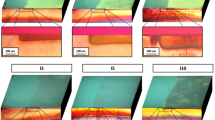Abstract
A sensitive, quantitative method for investigating changes in enamel mineralization of specimens subjected to in vitro or in situ experimentation is presented. The fluorescence-detecting instrument integrates a Xenon arc light source and an object positioning stage, which makes it particularly suitable for the nondestructive assessment of demineralized or remineralized enamel. We demonstrate the ability of in vitro quantitative light-induced fluorescence (QLF) to quantify changes in mineralization of bovine enamel discs that had been exposed in vitro to a demineralizing gel (n=36) or biofilm-mediated demineralization challenges (n=10), or were carried in situ by three volunteers during a 10-day experiment (n=12). Further experiments show the technique's value for monitoring the extent of remineralization in 36 specimens exposed in vitro to oral multispecies biofilms and document the repeatability of in vitro QLF measurements (n=10) under standardized assay conditions. The validity of the method is illustrated by comparison with transversal microradiography (TMR), the invasive current gold standard for assessing experimental changes in enamel mineralization. Ten discs with 22 measurement areas for comparison demonstrated a positive correlation between TMR and QLF (r=0.82). Filling a technological gap, this QLF system is a promising tool to assay in vitro nondestructively localized changes in mineralization of enamel specimens.







Similar content being viewed by others
References
Al-Khateeb S, ten Cate JM, Angmar-Månsson B, de Josselin de Jong E, Sundström G, Exterkate RAM, Oliveby A (1997) Quantification of formation and remineralization of artificial enamel lesions with a new portable fluorescence device. Adv Dent Res 11:502–506
Al-Khateeb S, Exterkate RAM, de Josselin de Jong E, Angmar-Månsson B, ten Cate JM (2002) Light-induced fluorescence studies on dehydration of incipient enamel lesions. Caries Res 36:25–30
Ando M, Hall AF, Eckert GJ, Schemehorn BR, Analoui M, Stookey GK (1997) Relative ability of laser fluorescence techniques to quantitate early mineral loss in vitro. Caries Res 31:125–131
Ando M, van der Veen MH, Schemehorn BR, Stookey GK (2001) Comparative study to quantify demineralized enamel in deciduous and permanent teeth using laser- and light-induced fluorescence techniques. Caries Res 35:464–470
Angmar-Månsson B, ten Bosch JJ (2001) Quantitative light-induced fluorescence (QLF): a method for assessment of incipient caries lesions. Dentomaxillofac Radiol 30:298–307
Geddes DAM (1975) Acids produced by human dental plaque metabolism in situ. Caries Res 9:98–109
Giertsen E, Guggenheim B, Thurnheer T, Gmür R (2000) Microbiological aspects of an in situ model to study effects of antimicrobial agents on dental plaque ecology. Eur J Oral Sci 108:403–411
Guggenheim B, Guggenheim M, Gmür R, Giertsen E, Thurnheer T (2004) Application of the Zürich biofilm model to problems of cariology. Caries Res 38:212–222
Hall AF, DeSchepper E, Ando M, Stookey GK (1997) In vitro studies of laser fluorescence for detection and quantification of mineral loss from dental caries. Adv Dent Res 11:507–514
Lagerweij MD, de Josselin de Jong E, ten Cate JM (1994) The video camera compared with the densitometer as a scanning device for microradiography. Caries Res 28:353–362
Mendes FM, Hissadomi M, Imparato JCP (2004) Effects of drying time and the presence of plaque on the in vitro performance of laser fluorescence in occlusal caries of primary teeth. Caries Res 38:104–108
Pretty IA, Edgar WM, Higham SM (2001) The use of QLF to quantify in vitro whitening in a product testing model. Br Dent J 191:566–569
Pretty IA, Edgar WM, Higham SM (2004) The validation of quantitative light-induced fluorescence to quantify acid erosion of human enamel. Arch Oral Biol 49:285–294
Schmidlin PR, Tepper SA, Scriba H, Lutz F (2002) In vitro assessment of incipient approximal carious lesions using computer-assisted densitometric image analysis. J Dent 30:305–311
Shapiro S, Giertsen E, Guggenheim B (2002) An in vitro oral biofilm model for comparing the efficacy of antimicrobial mouthrinses. Caries Res 36:93–100
Shi XQ, Tranaeus S, Angmar-Månsson B (2001) Comparison of QLF and DIAGNOdent for quantification of smooth surface caries. Caries Res 35:21–26
van der Ploeg JR, Guggenheim B (2004) Deletion of gtfC of Streptococcus mutans has no influence on the composition of a mixed-species in vitro biofilm model of supragingival plaque. Eur J Oral Sci 112:433–438
van der Veen MH, de Josselin de Jong E (2000) Application of quantitative light-induced fluorescence for assessing early caries lesions. Monogr Oral Sci 17:144–162
van Strijp AJP, van Steenbergen TJM, ten Cate JM (1997) Effects of chlorhexidine on the bacterial colonization and degradation of dentin and completely demineralized dentin in situ. Eur J Oral Sci 105:27–35
Acknowledgements
The authors are grateful for excellent technical assistance by Mark J. Buijs, Siren Østvold, and Steve Reese. This work was supported by the Universities of Zürich and Bergen, Patentmedelsfonden för Odontologisk Profylaxforskning (Sweden), Colgates Forskningsfond (Norway), and A/S Norsk Dental Depots Fond for Odontologisk Forskning (Bergen).
Author information
Authors and Affiliations
Corresponding author
Rights and permissions
About this article
Cite this article
Gmür, R., Giertsen, E., van der Veen, M.H. et al. In vitro quantitative light-induced fluorescence to measure changes in enamel mineralization. Clin Oral Invest 10, 187–195 (2006). https://doi.org/10.1007/s00784-006-0058-z
Received:
Accepted:
Published:
Issue Date:
DOI: https://doi.org/10.1007/s00784-006-0058-z




